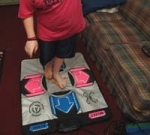Mar 29, 2006
Video games tackle 'lazy eye'
from BBC NEWS
By Gareth Mitchell
Presenter, Digital Planet, BBC World Service
Playing virtual reality computer games may help treat the condition known as amblyopia, or lazy eye, say researchers. In patients with amblyopia, one eye works better than the other. Because the amblyopic eye is inferior for some reason, the brain decides to use the good eye. Over time, the neural connection to the bad eye becomes gradually weaker in favour of the good eye. The traditional way of fixing the problem is for patients to force the bad eye to work harder by wearing a patch over the good eye. The treatment usually involves patching for around 400 hours and can cause the eyes not to work together, resulting in double vision.
"Traditionally VR has been used to present realistic environments in 3D so you imagine you're there because of the depth of the world around you," said Richard Eastgate of the university's Virtual Reality Applications Research Team.
"But we're using VR to make something unrealistic. You could call it virtual unreality," he told Digital Planet...
Read the full story from BBC NEWS
16:30 Posted in Cybertherapy, Serious games | Permalink | Comments (0) | Tags: serious gaming, cybertherapy
Feb 11, 2006
Cloud

19:45 Posted in Emotional computing, Meditation & brain, Serious games | Permalink | Comments (0) | Tags: emotional computing, serious gaming
Sep 19, 2005
Video games promoted as effective health-care training
Games for Health is a project produced by Serious Games Initiative to promote best practices, community building, and research into how cutting-edge game design and development methodologies can aid in the creation of health tools that range from direct patient application, to personal health education, and workforce initiatives.
Examples of these applications include the following:
- Dance Dance Revolution: The popular dance game from Konami features an exercise mode. You set goals and play while it reports calorie burn from game sessions.
- In The Netherlands, VSTEP (Virtual Safety Training and Education Platform) has enjoyed success developing 3-D simulations for low-cost PC hardware. The "virtual experiences" are used for training oil-rig workers, emergency services, port authorities, hospital staff and military.
- Cardiac Arrest: A computer adventure game that simulates the diagnosis and treatment procedures for people suffering from various forms of cardiac arrest.
- VR Phobia: The Virtual Reality Medical Center has modified commercial games to create effective treatments for patients suffering from common phobias, including fear of flying, spiders, heights, and driving.
More to explore:
The “Serious Games Summit” is being held October 31st - November 1st, 2005, in Washington D.C. Areas of discussion range from the military and government, to health and education.
http://www.seriousgamessummit.com/home.html
“Games For Health 2005″, September 22-23, 2005, Baltimore, Maryland.
http://www.gamesforhealth.org/events.html
11:55 Posted in Serious games | Permalink | Comments (0) | Tags: serious gaming
Jan 10, 2005
Play videogames to get fit
From WIRED
Company executives insist that "exergaming" or "exertainment" -- the marriage of physical exercise and video gaming -- is becoming a hot new niche, and the most bullish aficionados say it might even help reduce the nation's obesity epidemic.
The PlayZone was tucked into a back corner of a tent outside the main convention center, far from the gargantuan exhibits by Samsung, Sony, Panasonic and other popular brands.
Although scents reminiscent of a gym sometimes wafted out of the zone, the jam-packed area was popular with retailers and analysts. Six exhibitors -- many startups new to CES -- showed off digital putting greens, optical sensors in miniature dance floors, biofeedback devices and cutting-edge workout contraptions.
One race car simulation contraption -- Kilowatt Sport from Laurel, Maryland startup Powergrid Fitness -- looked similar to a NordicTrack cross-country ski machine hooked up to a wide-screen plasma television. Moving the hand controls while trying to stand up straight on the $800 machine requires extensive flexing of the muscles in the arms, back, abdominal area and thighs.
But most of the PlayZone devices, often played on PlayStations and Xboxes, didn't feel like exercise at all -- exactly what many exertainment companies like to hear.
"The most common question I get is, 'How is this exercise? I just don't see how this is a workout,'" said Abigail Whitting, customer support manager for Kilowatt, which won a CES innovation award. "But it will tone you. It is a workout."
Some exertainment executives say their gizmos can help trim the nation's expanding waistlines -- especially among children, who might be tricked into working out if they think they're merely playing a video game.
According to the Centers for Disease Control and Prevention, 16 percent of boys and 14.5 percent of girls ages 6 to 11 were obese in 1999 and 2000, the latest years studied. That compares with 4.3 percent of boys and 3.6 percent of girls from 1971 to 1974. A sedentary lifestyle was a big contributor to the increase, the CDC said.
"If anything can get your kids off the couch, this is it," said Shawn Clement, North American sales manager for Electric-Spin, the Canadian maker of the $250 Golf LaunchPad. "The whole idea is to get physical, not get lazy."
LaunchPad includes a small putting green with optical sensors within the turf and a tethered, regulation-weight ball that players knock off a standard tee. Players use their own clubs.
Its software has a swing analysis to measure the ball's speed, curve path and other statistics based on the club's trajectory. Serious players may disconnect the tether and use a real ball at an outdoor course, then get real-time analysis of each swing from a laptop computer.
"This is a great way to promote activity," Clement said. "It's not just your average video game."
But medical experts are skeptical. Although they applaud manufacturers for getting people off the couch, they caution against relying on technology alone to slim and tone the record number of out-of-shape Americans. They say individuals, communities, private industry and governments should work together to tackle the problem.
"These video games are certainly helpful but they're not going to solve the obesity epidemic because it's simply too overwhelming," said Frank Hu, a professor of nutrition and epidemiology at Harvard.
Hu authored a study published last month of 116,500 women, finding that people who were physically active but obese were almost twice as likely to die as those who were both active and lean. The Harvard report contradicted a popular notion that exercise alone -- regardless of weight or diet -- is enough to maintain a healthy lifestyle.
But experts' pessimism didn't dampen enthusiasm of Jason Enos, product manager for Konami Digital Entertainment, who soaked through his T-shirt after hours of demonstrating his company's smash hit, Dance Dance Revolution. Players tap their feet to the correct circle on a floor pad, based on cues on the screen.
Advanced levels require fancy footwork, but players work up a sweat even on the easiest level. Players may enter height and weight to determine calories burned per minute, and they may compete against 15 other people worldwide.
Since December 2003, the Japanese company has sold more than 2 million copies of the game -- a teen phenomenon at Japanese and American arcades in the early '90s -- for Sony's PlayStation systems. The software and plastic floor mat sell for $60.
"It's definitely a workout, and it's not nearly as boring as a stationary bike," said Enos, wiping sweat from his brow. "It breaks the mold of the passive video game genre."
10:15 Posted in Serious games | Permalink | Comments (0) | Tags: serious gaming






